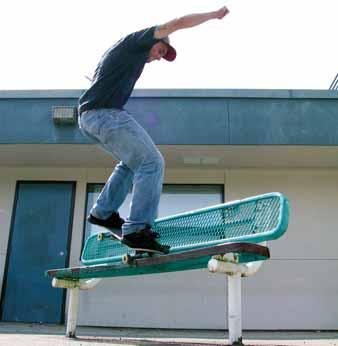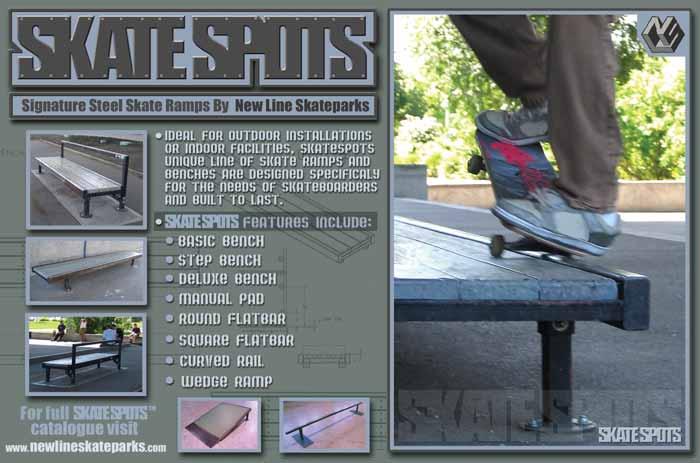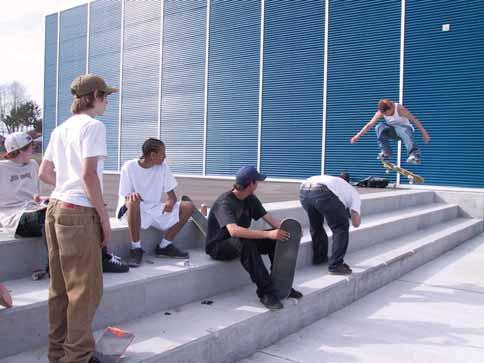
7 minute read
Schooling on skateboards
Schooling on PHOTOS COURTESY LUKE DOELL Skateboards
By Chris Parry, director of The Canadian Amateur Skateboard Association
Skateboarding and schoolyards are two nouns that play an integral role in the lives of countless youths across Canada. For skaters the words go together like “play” and “ground”. To school administrators and policymakers the words go together like “Skate and destroy.” Without getting too far into the debate of whether skateboarding causes cosmetic damage to property (it does) or the level of inconvenience or annoyance it creates for others (it can); this article aims to educate a bit about skateboarding and its history, explore reasons why kids skate at schools, share insights into the experience of the average youthful skater, and finally suggest some options for schools, administrators, and skaters to co-exist in a positive, safe and healthy environment.
Schoolyards and the birth of skateboarding From its inception, skateboarding has shared a special relationship with schoolyards. It is fairly common knowledge that modern skating's roots trace back to the surfers of southern California. They found the banked schoolyards of LA and San Diego to be perfect places to practice their landlocked surfing moves. But as skateboarding evolved and developed it's own identity, one not reliant on the surf style of
Skateable terrain is all around a school yard.

riding, a new style of skateboarding, commonly known as street skating, pushed skaters to constantly seek suitable locations or 'skate-spots'. Invariably the search for skatespots led them back to the schoolyards where they studied all week as schools provide an ample array of skateable objects to invent new tricks on and push the limits of what is possible on a board and four wheels. A cursory survey of skateboard videos, media, or video games further reveals the central role of schools as skatespots. The fact that skateboarding is largely a youth driven sport and culture only serves to reinforce this relationship.
Why do kids skate at schools? Why kids skate at schools seems pretty obvious. Skating is how skateboarders get around (like bike riders) and school is where they spend a majority of their waking hours. But there are other reasons as to why schools are prime skate terrain.
With the evolution of “street” skating came the ability of skaters to turn their surroundings into a “skatepark”. There
was no longer the need for specialized facilities when common architectural features such as ledges, handrails, stairs, and open flatground areas all became places where skaters could perform and perfect their tricks. In fact, skateboarding's incredible progression and enormous growth is due in large part to skateboarders' creative ability to utilize and celebrate what others see simply as a place to sit, an aid to travel down stairs, or a slab of cement to walk on. Unfortunately for school administrators and plant operators who often frown upon such creative utilization of school property, schoolyards have an abundance of the “natural” terrain that modern skaters seek.
Compounding the usage problem is the fact that the average community lacks sufficient, safe, and quality facilities or places for skateboarding youths to use. According to The Sporting Goods Manufacturers Association's Skateboard Participation Report 2003, “Skateboarding is the fastest growing “extreme” sport in the U.S. Since 1998, participation is up by 81% and frequent participation (52+ days/year) has surged by 173%.” A CTV news report estimated that there are over 1,000,000 skaters in Canada alone. Yet despite the numbers and growth, supply has not kept pace with demand in terms of facilities and programming. Without adequate places to skate that are within reasonable travel dis-
A student gets creative, a wall gets scuffed.

tances, the average school age skater simply uses the local schools as their playground. Schools are everywhere, skateparks are not. They see the fields, courts, and various other athletic op por tunities provided other students by the school system and assume that they should be treated with the same degree of respect, especially in light of the fact that more students skateboard than participate in many of these other “traditional” sports.

to students who choose that method of transportation. A second step would be to work with the skaters in your school and determine if it is possible to provide places and times to skate on school grounds. Experience shows that treating skaters with respect and involving them in the decision making process yields positive results. Identify desirable spots to skate (i.e. benches, ledges, “gaps”, etc.) and designate some of these as skateable at certain times. Liability and insurance issues should be treated similarly to other sporting amenities provided on campus. Most Canadian municipalities treat skateparks like they do other Skaters adapting — the bottom stair skatestoppers force a new line. recreational facilities with regards to risk and liability. The schoolyard: If the cosmetic property damage associated with skating A microcosm of the reality for skaters is deemed unacceptable, schools can try purchasing (or buildFrom a skaters' perspective, the rules, restrictions, and lack of ing) obstacles that replicate what the skaters are using and respect they encounter when they ride their boards to and at locating them in a place that deters skaters from skating in the school mirrors the reality they face in daily life beyond the “no-skate” zones. school halls. Anti-skateboarding rules, board confiscations, Other option schools may explore are forming skateand altering of benches, ledges, stairs, etc. to prevent skating board clubs or developing programming geared towards the are all common practices both at school and elsewhere. skaters in the school. A growing number of community and However, this marginalizing of a significant group of youths recreation centres are offering skate programming and the trying to practice a creative and healthy sport seems counter- feedback has been overwhelmingly positive. These clubs or productive to the overall goal of a school - to produce and programs generally involve having portable obstacles that are nurture healthy members of our community. “Cracking brought out for use after school or on weekends. Schools down” on skateboarding only serves to create anger, resent- could adopt this model and expand it to incorporate skating as ment, and increased anti-authority sentiments in skaters, and part of a physical education component. by extension students when this crack down occurs at school. A final option would be for schools to work with munic-
Moreover, years of cracking down on skating has done ipalities and community groups and build a skatepark on or little to deter its growth. Skaters have displayed a tenacious adjacent to school grounds. Abbotsford's skatepark, lo cated resilience and ability to adapt. When restrictions are enforced next to a secondary school has been a very successful experiand skatestoppers used, the “problem” migrates rather than ence for both the school and the skaters. School staff has disappears. This migration results in young skaters leaving noticed a marked reduction in skating on campus and skaters the relative safety of the schoolyard and moving to more dan- now have a safe, high quality facility to enjoy and develop gerous, less youth friendly places to skate. their skills. The proximity to the school also makes it easy for staff to monitor the park use during school hours. Longterm, Options: where can we go from here? building skateparks on or near school grounds opens the door Given that skateboarding is here to stay and that skaters form to extracurricular programming for skateboarding similar to a significant percentage of students participating in sport, the other intra-school competitive sports. question becomes what to do with or for them. A first step Due to the very real possibility of skateboarding becomwould be to acknowledge the physical fitness value of skat- ing an Olympic sport and an obvious need for some level of ing as a means of transportation and to allow skaters to use conventional organization, The Canadian Amateur their boards to commute to school. Rather than banning Skateboard Association (CASA) has been resurrected to skateboards outright, provide a place for boards to be stored address and answer questions regarding skateboarding. while class is in session just as bike racks are made available Please visit their website at www.ca-sa.ca for more info.

No trans fat... all the flavour. Trust the Windmill.

Old Dutch is celebrating 50 years of providing Western Canadians with premium quality snack favourites. This summer watch for the new trans fat-free symbol on our products. Old Dutch - Proudly Supporting Active Communities for Over 50 Years.










